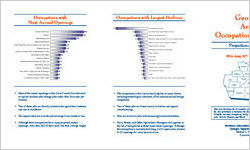Occupations with Most Annual Openings
Farmers & Ranchers Cashiers
Retail Salespersons Waiters & Waitresses Comb. Food Prep. & Serving Workers, Incl. Fast Food
Registered Nurses Laborers & Freight, Stock, & Material Movers, Hand
Stock Clerks & Order Fillers Child Care Workers
Elementary School Teachers, Ex. Spec. Ed. Office Clerks, General Teacher Assistants
Farm, Ranch, & Other Agricultural Managers General & Operations Managers
Truck Drivers, Heavy & Tractor-Trailer
130 120 120 110 80 70 70 70 70 60 60 60
260 250 200
Most of the annual openings in this list will result from the need to replace workers who change jobs rather than from new job creation.
Two of these jobs are directly related to the agricultural industry and one to healthcare.
Ten require short-term on-the-job training of one month or less.
Although these occupations have many projected annual openings, more than half of them pays less than average wages.
Occupations with Largest Declines
-350
-140 -130 -110 -90 -90 -80 -80 -70 -60 -50 -50 -50 -50 -40
Sew ing Machine Operators Secretaries, Except Legal, Medical, & Executive Maids & Housekeeping Cleaners Sales Reps., Wholesale & Manuf., Ex. Tech. & Scientific Products Inspectors, Testers, Sorters, Samplers, & Weighers Machine Feeders & Offbearers Bookkeeping, Accounting, & Auditing Clerks Cooks, Fast Food Order Clerks Dishw ashers Farm, Ranch, & Other Agricultural Managers Graders & Sorters, Agricultural Products Loan Interview ers & Clerks Tellers Cut., Punch., & Press Mach. Setrs., Opers., & Tndrs., Metal & Plastic
The occupations in this list are declining due to many factors, including technological advances, office automation and foreign competition.
Two of these jobs are found mainly in textiles and apparel manufacturing.
Four are in clerical jobs with increasingly automated duties.
Farm, Ranch, and Other Agricultural Managers also appears in the list of occupations with the most annual openings. Although this occupation is currently declining, it will require new workers to fill openings for many years to come.
Georgia Area
Occupational Trends
Projections to 2010
WIA Area #17 SW Georgia
This area includes the 14 counties of southwest Georgia in and around the city of Albany. It includes the following counties: Baker, Calhoun, Colquitt, Decatur, Dougherty, Early, Grady, Lee, Miller, Mitchell, Seminole, Terrell, Thomas and Worth.
Workforce Information & Analysis Division Georgia Department of Labor Michael L. Thurmond Commissioner
Total employment in WIA Area #17 is expected to reach more than 185,000 jobs by the year 2010, with almost 1,600 new jobs added each year. The area's economy is currently lagging behind both the state's and the nation's economy. Area job growth is expected to be 0.9 percent per year, while Georgia's job growth is expected to be 1.8 percent per year and the nation is expected to have annual job growth of 1.4 percent.
Area Highlights
This area is the chief producer of agricultural products in Georgia.
It is the largest producer of both peanuts and pecans in the United States.
This area is also a principal producer of food and kindred products, apparel and other textile mill products, and lumber and wood products.
Area population grew by only 10.1 percent over the ten years 1990 to 2000, among the smallest increases in the state. In contrast, Georgia's population grew at a rate of 25.8 percent over the same period.
Total personal income grew by 68.0 percent, compared to a rate of 98.2 percent for the state as a whole.
For copies of the Georgia Career Planner, Georgia Occupational Trends in Brief
or this publication, call 404/232-3875 or contact your local
Department of Labor office.
Fastest Growing Occupations
Registered Nurses Nursing Aides, Orderlies, & Attendants
Teacher Assistants Comb. Food Prep. & Serving Workers, Incl. Fast Food
Child Care Workers Cashiers
Waiters & Waitresses Farmers & Ranchers Retail Salespersons Office Clerks, General Packers & Packagers, Hand General & Operations Managers Elementary School Teachers, Ex. Spec. Ed. Truck Drivers, Heavy & Tractor-Trailer Laborers & Freight, Stock, & Material Movers, Hand
2.6% 2.3% 1.9% 1.7% 1.6% 1.5% 1.1% 1.1% 1.1% 0.9% 0.9% 0.8% 0.8% 0.8% 0.6%
These fast-growing occupations will have better employment prospects than occupations with slow or declining employment. Also, conditions will be more favorable for mobility and advancement.
The two fastest growing occupations are found in the healthcare industry.
Twelve of these jobs do not require any formal education beyond high school.
Occupations with Largest Job Growth
Farmers & Ranchers Registered Nurses Cashiers
Retail Salespersons Nursing Aides, Orderlies, & Attendants
Computer Support Specialists Teacher Assistants
Customer Service Representatives Comb. Food Prep. & Serving Workers, Incl. Fast Food
Home Health Aides Medical Assistants Automotive Service Technicians & Mechanics Child Care Workers Computer Softw are Engineers, Applications Truck Drivers, Heavy & Tractor-Trailer
730 640 460 400 370 350 330 280 280 260 230 230 230 230
1,750
These 15 occupations out of more than 700 - are projected to add almost 6,800 jobs over the next 10 years, about 43 percent of all projected job growth in this area.
Nine occupations require short-term on-the-job training of one month or less and four require some formal education beyond high school.
Four are in the healthcare industry and two are computerrelated.
Equal Opportunity Employer/Program Auxiliary Aids and Services Available upon Request to Individuals with Disabilities
